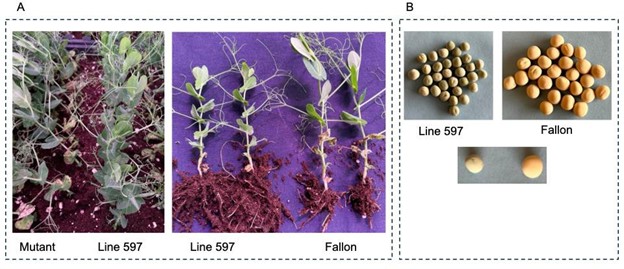Breakthrough Genetic Resistance to Ascochyta Blight in Field Pea
Licensable Mutant Line L597 Offers Stable, Heritable Resistance to Didymella pinodes for Sustainable Crop Improvement
Background:
Ascochyta blight (AB), particularly from the pathogen Didymella pinodes, causes severe foliar damage and yield losses of 15% to 75% in field pea (Pisum sativum L.). Traditional breeding efforts have failed to identify strong natural resistance within cultivated germplasm. Resistance from wild species has proven difficult to introgress into elite varieties, leaving growers highly dependent on fungicides and susceptible cultivars.
Technology Overview:
Researchers at Montana State University developed a chemically induced mutant pea population using Ethyl Methanesulfonate (EMS), successfully generating heritable genetic variation in over 6,800 M3 lines. Screening of these mutants identified a novel pea line, L597, with enhanced resistance to D. pinodes. The resistance was consistent in progeny (line 23-LH-17), demonstrating stability and potential for breeding integration.

Figure 1: Mutant lines showing some level of resistant to D. pinodes. (A) Infection type of Mutant lines and Fallon inoculated with D. pinodes. (B) Morphorlogical variation of between L597 and Fallon in seed coat color and size. Annan, E. (2025)
Benefits:
- First-of-its-kind resistance: Offers a new resistance source to D. pinodes not found in natural pea populations.
- Environmentally sustainable: Reduces reliance on fungicides for AB control.
- Low regulatory barrier: Developed through non-transgenic mutation breeding, facilitating faster commercialization compared to GMOs.
- Compatible with breeding programs: Resistance is stably inherited and available in a diploid, self-pollinating background.
- Multiple trait utility: Mutant population also includes variation in traits like dwarfism, branching architecture, and seed yield, enabling broader breeding applications.
Applications:
- Pea variety development: Integration of the L597 resistance allele into commercial cultivars.
- Seed company pipelines: Licensing for hybridization and trait stacking in elite germplasm.
- Crop improvement R&D: Use of mutant lines for functional genomics, QTL mapping, and trait discovery.
- Resilient agriculture: Contributing to climate-resilient and disease-tolerant cropping systems globally.
Opportunity:
- Available for exclusive license: resistant germplasm (pea line L597 and progeny line 23-LH-17), biological materials, and associated technical data
- Potential to collaborate in ongoing research
- Potential to introduce MSU’s Ascochyta blight–resistant trait into partner’s proprietary recurrent parent lines
IP Status:
- Provisional patent application filed
Contact:
Madeleine Doak
(406) 994-7868
mjdoak@montana.edu
